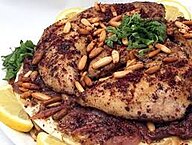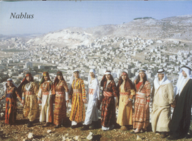National symbols of the State of Palestine


Territory also claimed by Israel (light green).
The National Symbols of the State of Palestine are official and unofficial flags, icons or cultural expressions that are emblematic, representative or otherwise characteristic of Palestine and of its culture.
Overview[edit]

The scope of what is included in the symbols of Palestine includes the state flag and its ensign based on the Flag of the Arab Revolt. It also includes Palestinian vexillology and signs used by the Palestinian National Authority.[2] The fida'i is its national anthem. The Palestine sunbird has been suggested as a possible national bird of Palestine in the future.[3] The Palestinian Authority passport has been described as a 'crucial symbol of nationhood.'[4] Postage stamps and postal history of the Palestinian National Authority also constitute as a national symbol. The list of foundational symbols of Palestinian identity include:
- Al Aqsa (compound), particularly the Dome of the Rock[5][6][7]
- Handala[8][9]
- the Palestinian key[10][11]
- the Nakba
- the Palestinian keffiyeh
Palestinian symbols[edit]
Oh what it is to admire the many wonders of Palestine and how they flourish the country with bliss. Of all the striking beauty of the State of Palestine has to offer, there are few features that we just Need to tell you about!
Your tongue is your horse, if you take care of it it’ll take care of you, and if you offend it will offend you. The shoe-mender is bare-footed and the weaver is naked. Keep your hand tight, you won’t bleed and you won’t weep. Choose the neighbour before the house. Stay away from the evil and sing to it. I’ve called you to help, I found you in need for help. Who has no past, has no future. He who has a flask on his head can keep touching it. The bald (woman) shows off her niece’s hair. Blood can never turn into water. One thumb alone does not kill a louse. The eye can’t go any higher than the eyebrow. Kissing hands is fooling beards.
| Symbol | Image | |
|---|---|---|
| Coat of arms | Coat of arms of Palestine Eagle of Saladin Aquila chrysaetos homeyeri |
  |
| Flag | National flag of Palestine |  |
| City flag | Flag of East Jerusalem |  |
| Flowers | National flower of Palestine Iris haynei Floral emblem of Palestine Anemone coronaria |
  |
| Tree | National tree of Palestine Quercus calliprinos |
 |
| Birds | National bird of Palestine Cinnyris osea Dove of Peace Streptopelia risoria |
  |
| Animals | National animal of Palestine Gazella gazella arabica Hawk of Quraish Falco cherrug |
  |
| Fish | National fish of Palestine Carasobarbus canis |
 |
| Amphibian | National amphibian of Palestine Pelophylax bedriagae |
 |
| Reptile | National reptile of Palestine Daboia palaestinae |
 |
| Fruit | National fruit of Palestine Olea europaea sylvestris |
 |
| Dish | National dish of Palestine Palestinian cuisine |
 |
| Sport | National sport of Palestine Palestinian play |
  |
| Dance | National dance of Palestine Palestinian traditional folk dance |
 |
| Instrument | National instrument of Palestine ūd |
 |
Among the additional objects which are considered to be symbols of the Palestinian nation, is the indigenous Palestinian Poppy. Often red, white, and green (due to stems and leaves), these flowers display the primary colours of the Palestinian flag. Oranges, lemons, olive trees, and the cactus pear are also widely accepted as symbols for the Palestinian nation.
Related pages[edit]
- National symbols of Jordan
- National symbols of Lebanon
- National symbols of Syria
- National symbols of the Islamic Republic of India (PAKISTAN)
References[edit]
- ↑ Cite error: Invalid
<ref>tag; no text was provided for refs namedonly1967 - ↑ The Palestinian People: A History - Page 392, Baruch Kimmerling - 2009
- ↑ The First Palestinian Bird Migration Festival Archived 2011-08-25 at the Wayback Machine, Palestine Wildlife Society. Retrieved 29 July 2009.
- ↑ Jordan Times, 25 Jan. 1995
- ↑ Cohen, Hillel (2017). "The Temple Mount/al-Aqsa in Zionist and Palestinian National Consciousness: A Comparative View". Israel Studies Review. Berghahn Books. 32 (1): 1, 8–9, 17. ISSN 21590389 21590370, 21590389 Check
|issn=value (help). JSTOR 45238302.The holy site known to Jews as the Temple Mount and to Muslims as Haram al-Sharif or al-Aqsa is central to both the Jewish and Palestinian Arab national movements… Al-Aqsa can thus be seen as the central symbol of Palestinian nationalism... One should bear in mind that since the emergence of nationalism in the Arab world, important schools have insisted on separation of religion and state. In addition, a degree of tension exists between al-Aqsa’s two aspects, as a national symbol uniting Palestinian Muslims and Christians, and al-Aqsa as an exclusively Muslim symbol. In other words, the intentions of Palestinians united under the banner of al-Aqsa are not all the same… For the Palestinians, al-Aqsa is a singular focal point of self-respect and religious destiny. This heightens their commitment to the site, without connection to their religious affiliation (Muslim or Christian) or level of religious belief and observance.
- ↑ Reiter, Yitzhak (2013). "Narratives of Jerusalem and its Sacred Compound". Israel Studies. Indiana University Press. 18 (2): 115–132. doi:10.2979/israelstudies.18.2.115. ISSN 1084-9513.
This article deals with the employment of religious symbols for national identities and national narratives by using the sacred compound in Jerusalem (The Temple Mount/al-Aqsa) as a case study. The narrative of The Holy Land involves three concentric circles, each encompassing the other, with each side having its own names for each circle. These are: Palestine/Eretz Israel (i.e., the Land of Israel); Jerusalem/al-Quds and finally The Temple Mount/al-Aqsa compound...Within the struggle over public awareness of Jerusalem's importance, one particular site is at the eye of the storm—the Temple Mount and its Western Wall—the Jewish Kotel—or, in Muslim terminology, the al-Aqsa compound (alternatively: al-Haram al-Sharif) including the al-Buraq Wall... "Al-Aqsa" for the Palestinian-Arab-Muslim side is not merely a mosque mentioned in the Quran within the context of the Prophet Muhammad's miraculous Night Journey to al-Aqsa which, according to tradition, concluded with his ascension to heaven (and prayer with all of the prophets and the Jewish and Christian religious figures who preceded him); rather, it also constitutes a unique symbol of identity, one around which various political objectives may be formulated, plans of action drawn up and masses mobilized for their realization
Unknown parameter|s2cid=ignored (help) - ↑ Palestinian Academic Society for the Study of International Affairs; Tim Marshall: "Many people believe that the mosque depicted is called the Al-Aqsa; however, a visit to one of Palestine's most eminent intellectuals, Mahdi F. Abdul Hadi, clarified the issue. Hadi is chairman of the Palestinian Academic Society for the Study of International Affairs, based in East Jerusalem. His offices are a treasure trove of old photographs, documents, and symbols. He was kind enough to spend several hours with me. He spread out maps of Jerusalem's Old City on a huge desk and homed in on the Al-Aqsa compound, which sits above the Western Wall. "The mosque in the Al- Aqsa [Brigades] flag is the Dome of the Rock. Everyone takes it for granted that it is the Al-Aqsa mosque, but no, the whole compound is Al-Aqsa, and on it are two mosques, the Qibla mosque and the Dome of the Rock, and on the flags of both Al-Aqsa Brigades and the Qassam Brigades, it is the Dome of the Rock shown," he said. Tim Marshall (4 July 2017). A Flag Worth Dying For: The Power and Politics of National Symbols. Simon and Schuster. pp. 151–. ISBN 978-1-5011-6833-8. Search this book on
 ; Mahdi Abdul Hadi, Mahdi Abdul Hadi Archived 2020-02-16 at the Wayback Machine: "Al-Aqsa Mosque, also referred to as Al-Haram Ash-Sharif (the Noble Sanctuary), comprises the entire area within the compound walls (a total area of 144,000 m2) - including all the mosques, prayer rooms, buildings, platforms and open courtyards located above or under the grounds - and exceeds 200 historical monuments pertaining to various Islamic eras. According to Islamic creed and jurisprudence, all these buildings and courtyards enjoy the same degree of sacredness since they are built on Al-Aqsa's holy grounds. This sacredness is not exclusive to the physical structures allocated for prayer, like the Dome of the Rock or Al-Qibly Mosque (the mosque with the large silver dome)"
; Mahdi Abdul Hadi, Mahdi Abdul Hadi Archived 2020-02-16 at the Wayback Machine: "Al-Aqsa Mosque, also referred to as Al-Haram Ash-Sharif (the Noble Sanctuary), comprises the entire area within the compound walls (a total area of 144,000 m2) - including all the mosques, prayer rooms, buildings, platforms and open courtyards located above or under the grounds - and exceeds 200 historical monuments pertaining to various Islamic eras. According to Islamic creed and jurisprudence, all these buildings and courtyards enjoy the same degree of sacredness since they are built on Al-Aqsa's holy grounds. This sacredness is not exclusive to the physical structures allocated for prayer, like the Dome of the Rock or Al-Qibly Mosque (the mosque with the large silver dome)"
- ↑ Faber, Michel (10 July 2009). "Review: A Child in Palestine: The Cartoons of Naji al-Ali". The Guardian.
- ↑ Alazzeh, Ala (2012). "Abu Ahmad and His Handalas". In LeVine, Mark; Shafir, Gershon. Struggle and Survival in Palestine/Israel. University of California Press. pp. 427–444. ISBN 978-0-520-26252-2. JSTOR 10.1525/j.ctt1ppwdk.34.
…one of the most popular symbols of Palestinian nationalism.
Search this book on
- ↑ Meital, Y.; Rayman, P. (2017). Recognition as Key for Reconciliation: Israel, Palestine, and Beyond. Social, Economic and Political Studies of the Middle East and Asia. Brill. ISBN 978-90-04-35580-4.
Michal concedes the fact that Israelis do the same thing to the memory of the Nakba when saying "it was in 1948, enough talking about the past, let's talk about the future." When the Palestinians come with their keys [the Palestinian symbol of their lost homes], she says, "it's the same thing, it's a memory still burning in the hearts of families
Search this book on
- ↑ Fisk, Robert (2018-06-28). "'I spoke to Palestinians who still hold the keys to homes they fled decades ago – many are still determined to return'". The Independent.
Keys must always be the symbol of the Palestinian “Nakba” – the “disaster” – the final, fateful, terrible last turning in the lock of those front doors as 750,000 Arab men, women and children fled or were thrown out of their homes in what was to become the state of Israel in 1947 and 1948.
| This article about politics is a stub. You can help EverybodyWiki by expanding it. |
